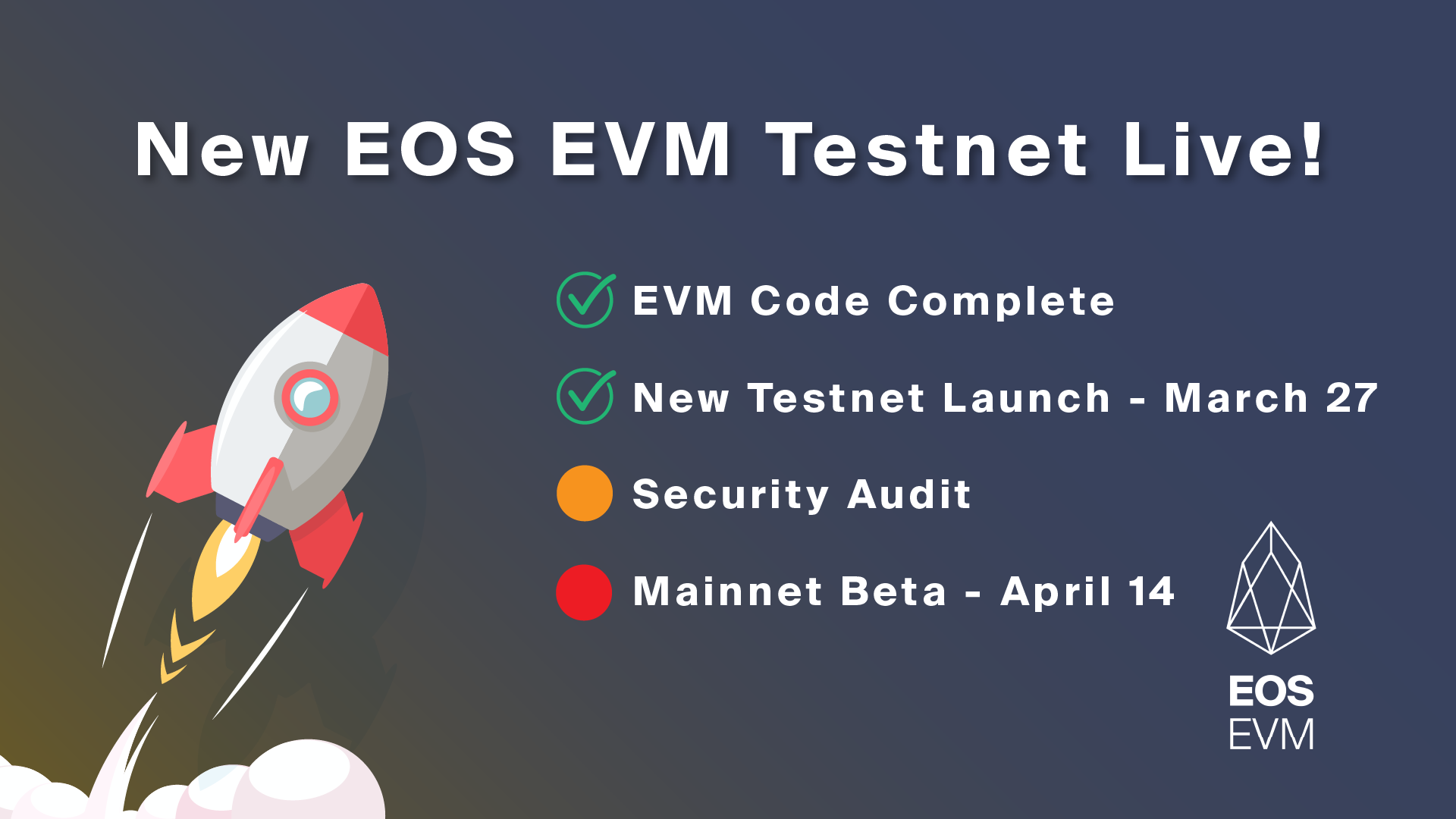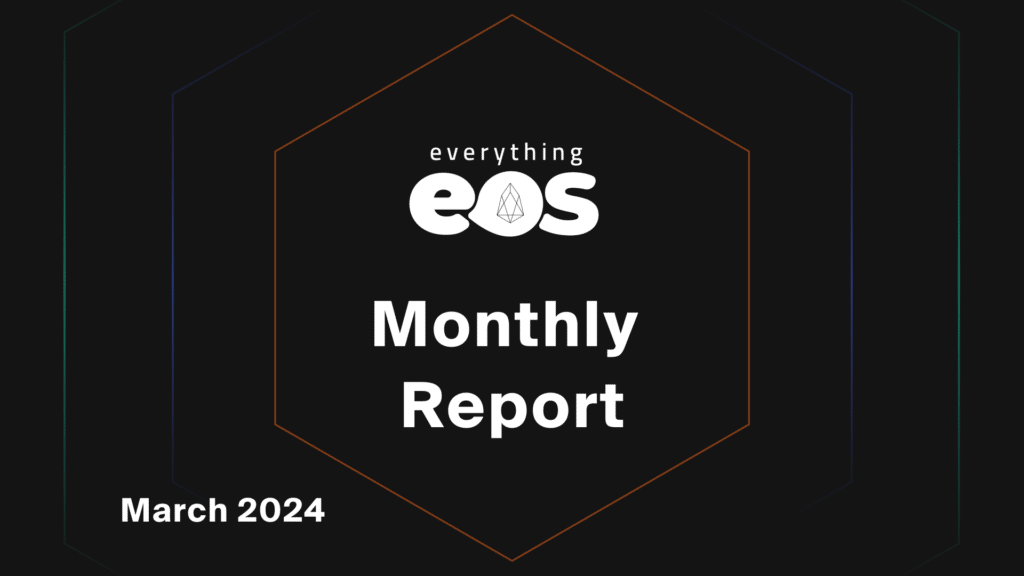The final testnet before mainnet launch for the EOS EVM is officially live and mainnet is slated to launch on April 14th 2023! This is an exciting milestone for the EOS community, with the pending security audit being the only major milestone left before the EOS EVM Mainnet Beta is launched.
If you’re a developer looking to build on the EOS EVM or project wanting to start exploring the opportunities for integration, this article will get you up to speed on everything you need to know. After looking at some of the most recent news surrounding the EVM, we’ll take a look at some Frequently Asked Questions and finally provide some information on how you can get building on the EOS EVM quickly.
What is the EOS EVM?
The EOS EVM is an emulation of the Ethereum EVM, housed within an EOS smart contract. It offers feature parity to other EVMs in the space but with unmatched speed, performance and compatibility. This is all thanks to the architecture of the design and the powerful nature of EOS native. Learn more about the technical architecture of the EOS EVM in our recent deep dive on the topic here.
Funding Support Grows for EOS EVM Projects
Recently, EOS Network Ventures announced a formal commitment of $20M directly into the EOS EVM and GameFi projects. The goal of this investment is to quickly establish EOS EVM as a market-leader and attract the industry’s best developer’s and teams to build in the ecosystem.
This is in addition to the other funding opportunities already available through Pomelo and the ENF Grant Framework. Learn more about the various initiatives funding development on the EOS EVM here.
Get Up and Running Quickly on the EOS EVM
For the technically minded readers wanting to start playing around with the EOS EVM on testnet or deploying smart contracts, here is the information you need to know.
EOS EVM Contract account: eosio.evm
Ethereum Compatible RPC Endpoint
api.testnet.evm.eosnetwork.com
EOS EVM Block Explorer:
explorer.testnet.evm.eosnetwork.com
Token Bridge:
bridge.testnet.evm.eosnetwork.com
Token Faucet:
faucet.testnet.evm.eosnetwork.com
chain-id: 15557
EOS Learn Portal: https://learn.eosnetwork.com/
EOS Docs: https://docs.eosnetwork.com/
EOS EVM Developer Chat: https://t.me/eosevm
Frequently Asked Questions About the EOS EVM
As the EOS EVM nears mainnet launch, a number of questions have come up in the EOS community regarding this area of the ecosystem. Here are some answers to the most common queries.
What is an EVM and what does it do?
EVM stands for Ethereum Virtual Machine, the original EVM is an engine made up of a series of Solidity smart contracts that powers the Ethereum ecosystem. It allows for users to interface with the Ethereum network and for developers to deploy decentralized applications (dApps) that are written in Solidity.
Since the launch of Ethereum, a number of other EVMs have been released that are meant to improve upon the original EVM by overcoming issues such as scalability. The EOS EVM serves a similar purpose, by allowing projects that were built on the Ethereum network to be launched on the EOS Network.
How does EOS EVM differ from other EVMs?
The EOS EVM is extremely performant, as it’s designed on top of the powerful EOS native network. EOS EVM will offer negligible gas fees and transaction speeds that are faster than any other EVM on the market. From a development standpoint, it is more compatible than other Ethereum alternatives thanks to design choices such as one second block times.
More details on the technical features and architecture can be found in the EOS EVM Architecture Deep Dive.
What is the difference between EOS Native and EOS EVM?
EOS native is the base layer of the EOS Network, utilizing Antelope architecture and a Delegated Proof of Stake consensus mechanism. Many of the basic primitives to blockchain such as smart contracts, wallets and network nodes are present on EOS native but the overall architecture and user experience is quite different from Ethereum.
From a developer perspective, on EOS native, smart contracts are developed using C++, a popular language amidst traditional developers due to its speed and robust libraries. Other languages such as Rust can also be used on EOS native but the base layer of the network is executed in C++. On Ethereum, smart contracts are primarily written in Solidity.
Additionally, developers on EOS native have the option to stake resources for their user, removing the need for a traditional wallet in certain applications and allowing for an experience that is much closer to Web2. On Ethereum, users must always have a traditional wallet to interface with the blockchain.
The user experience also differs in that on EOS native the gas fees that are present on EVMs are not part of native. Instead, users stake tokens to cover resources that can be used for a number of transactions. The cost of this is extremely negligible. EOS native offers even faster transaction times than the EOS EVM with 0.5 second block times and up to 10,000 transactions per second. Those interested in learning more about EOS native can check out the EOS documentation.
What programming languages can be used to write smart contracts for EOS EVM?
Due to the feature parity of the EOS EVM to the Ethereum network, any programming language executed in the Ethereum environment can also be utilized on the EOS EVM. The most prominent language for Ethereum is Solidity, but other Ethereum compliant languages such as Vyper, Yul and Yul+ are also compatible.
What is the gas fee and how does it work in EOS EVM?
The gas fee is what covers the cost of a user transaction on the EOS EVM. While there are no gas fees on EOS native, gas fees are part of the traditional EVM architecture and an important part of the way users interact with EVM based smart contracts. So, a gas fee has been built into the design of the EOS EVM. A user pays the fee on EOS EVM in their wallet, the same way they would on any other EVM based chain. Then those resources are then sent to EOS native to cover the resources being used by the EOS EVM smart contract, in order to execute that action.
Are there any functionality limitations that can be achieved on Ethereum and not on EOS EVM?
No, the EOS EVM offers feature parity to the Ethereum EVM environment. Any function that can be executed on the Ethereum network can also be executed on the EOS EVM. Developer’s coming to the EOS EVM from other EVMs will find that the ecosystem is extremely similar and easy to familiarize with.
EOS EVM Mainnet Has Never Been Closer!
Launching the testnet for EOS EVM is a big victory for the community. This initiative been a year in the works and will be well worth the wait, opening up the EOS ecosystem to a slew of new developers, projects and users. With the final security audit pending and mainnet slatted to launch on April 14th, there’s never been a better time to start building on EOS!
EOS Network
The EOS Network is a 3rd generation blockchain platform powered by the EOS VM, a low-latency, highly performant, and extensible WebAssembly engine for deterministic execution of near feeless transactions; purpose-built for enabling optimal Web3 user and developer experiences. EOS is the flagship blockchain and financial center of the Antelope framework, serving as the driving force behind multi-chain collaboration and public goods funding for tools and infrastructure through the EOS Network Foundation (ENF).
EOS Network Foundation
The EOS Network Foundation (ENF) was forged through a vision for a prosperous and decentralized future. Through our key stakeholder engagement, community programs, ecosystem funding, and support of an open technology ecosystem, the ENF is transforming Web3. Founded in 2021, the ENF is the hub for EOS Network, a leading open source platform with a suite of stable frameworks, tools, and libraries for blockchain deployments. Together, we are bringing innovations that our community builds and are committed to a stronger future for all.



